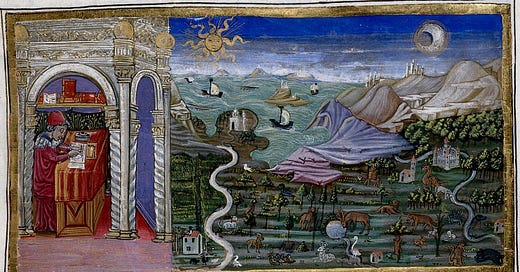Welcome to
. What follows is the first ever edition of Terra Phantasma — a new series where we’ll be looking at the mysterious ‘phantom lands’ that have appeared on maps through the ages. For the full map of Cosmographia posts, see here.‘Over the Mountains Of the Moon, Down the Valley of the Shadow, Ride, boldly ride,’ The shade replied,— ‘If you seek for Eldorado!’― Edgar Allan Poe, from ‘Eldorado’ (1849)
The greatest of the great rivers, the Nile yawns into the Mediterranean at the end of a four thousand mile journey. The river has acted as a snaking oasis for time immemorial, bringing life to the desert and quenching the empires that have risen and fallen along its banks since the earliest days of civilisation. Its size is such that from space it appears to drape across Africa, coiling and straightening across nations like Jörmungandr himself, the World Serpent.
For millennia, those sustained by its waters have looked upstream and wondered from whence it came. Alexander the Great, Julius Caesar, Nero, the Persian emperors Cyrus the Great and his son, Cambyses, Greek, Roman, and Arab geographers — all are documented to have wondered at the origins of this great torrent. Where and what, they asked, was the source of the mighty River Nile?
In the fifth century BC, Herodotus, the Greek scholar and ‘Father of History’, travelled to Egypt, busying himself with learning as much as he could of the country’s culture, geography, and history. In his great treatise The Histories (c. 430 BC), he writes:
But as to the sources of the Nile, no one that conversed with me, Egyptian, Libyan, or Greek, professed to know them, except the recorder of the sacred treasures of Athena in the Egyptian city of Saïs. I thought he was joking when he said that he had exact knowledge, but this was his story. Between the city of Syene in the Thebaid and Elephantine, there are two hills with sharp peaks, one called Crophi and the other Mophi. The springs of the Nile, which are bottomless, rise between these hills; half the water flows north towards Egypt, and the other half south towards Ethiopia. He said that Psammetichus King of Egypt had put to the test whether the springs are bottomless: for he had a rope of many thousand fathoms' length woven and let down into the spring, but he could not reach to the bottom.
Five centuries later, in his great treatise, Geographia, the Greek-Alexandrian polymath Claudius Ptolemy had a different, and more enduring, answer. He wrote of an early traveller who claimed to have seen the source for himself.






